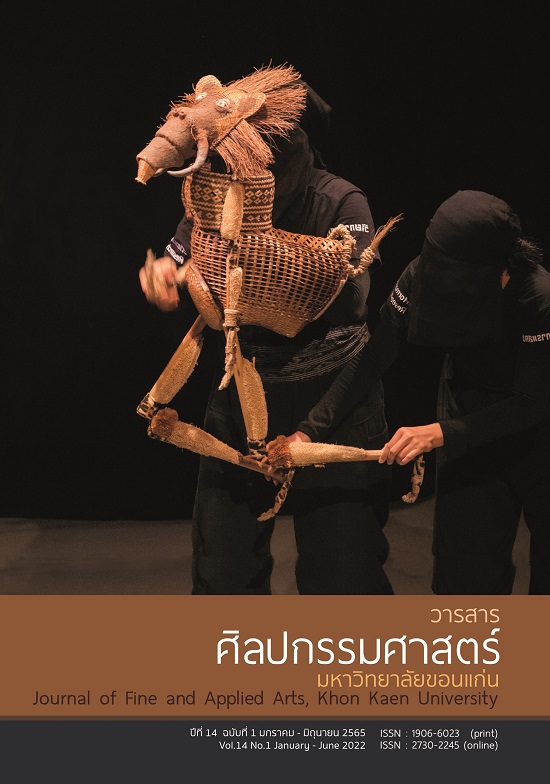The way of production and transferring arts and crafts heritage of the water village (Kampong Ayer) in Brunei Darussalam
Main Article Content
Abstract
The objective of this qualitative research was to investigate the way of production and transferring arts and crafts heritage in the water village of Brunei Darussalam. Data were collected from documents and from the field through observation and in-depth interview with a target group consisting of 3 craftsmen, 12 villagers, 2 village leaders and 4 government officials. The data were validated and concluded using descriptive analysis. There are various types of arts and crafts in the water village such as basketry, metalwork and weaving. Each type of handicraft has different methods of production. An outstanding basketry is food-tray covers or Tudung Dulang made of leaves in the Pandanaceae family. Leaves are dried and dyed in different colors and woven into food covers. The outstanding metalwork is the Kris made of a piece of iron that is heated and hammered repeatedly until it is flat, then it is shaped, filed, polished and immersed in vinegar before use. The handle and sheath are made of fine-texture wood. Woven fabrics are made by machine like other fabrics, but the outstanding brocade fabric is Jong Sarat. Presently, this material is usually used in royal ceremonies like coronation and wedding ceremonies. Sometimes it is used for decorating rooms or as souvenirs. Arts and crafts are inherited in the family through trial and error, demonstration or transfer in the institutional system by the Brunei Arts and Handcraft Training Centre under the Royal Office with the aims to encourage people to have awareness and to inherit their cultural heritage, to provide free training courses for children and youths, to transfer knowledge to people in the water village to do related business, and to add value and make Brunei handicrafts better-known.
Article Details

This work is licensed under a Creative Commons Attribution-NonCommercial-NoDerivatives 4.0 International License.
Content and information in articles published in the Journal of Fine and Applied Arts of Khon Kaen University is regarded as the opinion and sole responsibility of the author(s) directly; therefore, editors are not obliged to agree to or share any responsibility with regard to the content and information that appears within these articles.
All articles, information, content, image, etc. that have been published in the Journal of Fine and Applied Arts of Khon Kaen University is the copyright of the Journal of Fine and Appllied Arts of Khon Kaen University. Any person or organization who wishes to distribute all or parts of the articles for further dissemination or other usage must first receive permission from the Journal of Fine and Applied Arts of Khon Kaen University before proceeding to do so.
References
ตรีพูลศักดิ์ เอกโรจนกุล. (ผู้แปล). (ม.ป.ป.). มรดกภูมิปัญญาทางวัฒนธรรมและการพัฒนาที่ยั่งยืนขององค์การยูเนสโก. ค้นเมื่อ 20 สิงหาคม 2563 จาก https://ich.unesco.org/doc/src/34299-TH.pdf
ปิ่นรัฐ กาญจนัษฐิติ. (2552). การอนุรักษ์มรดกสถาปัตยกรรมและชุมชน. กรุงเทพฯ : จุฬาลงกรณ์มหาวิทยาลัย.
รมิดา ชั้นพรภักดี และทรงชัย ทองปาน. (2563). Wawasan Brunei 2035 และโอกาสด้านการค้าและการลงทุนของประเทศไทย. วารสารสังคมวิจัยและพัฒนา, 2(1), 1-9.
สมศักดิ์ ศรีสันติสุข. (2552). การศึกษาสังคมและวัฒนธรรม แนวความคิด วิธีวิทยา และทฤษฎี. ขอนแก่น : มหาวิทยาลัยขอนแก่น.
สุภางค์ จันทวานิช. (2558). ทฤษฎีสังคมวิทยา. กรุงเทพฯ : จุฬาลงกรณ์มหาวิทยาลัย.
Ahmad, M. D. B. (1996). Traditional Handicrafts of Brunei Darussalam. Bandar seri Begawan : The Information Development Prime, Minister’s Office Brunei Darussalam.
Binchin, P. (1998). The role of the Brunei Art and Handicraft Training Centre in preserving traditional crafts. In Thumboo, Edwin, T. (Ed.) Culture in ASEAN & The 21stcentury. Singapore: UniPress NVS.
Brunei Arts and Handcrafts Training Centre. (2010). Brunei Arts and Handcrafts. Bandar Seri Begawan : BAHT Centre.
Haji Ibrahim, A. L. (1971). Variations and changes in the name and locations of the wards of Brunei’s Kampong Ayer over the last century. The Brunei Museum Journal, 2(3), 56-73.
Haji Julaini, S. S. B. (2014). Traditional Handicraft of Brunel Darussalam. 4th ed. Bunda seri Begawan : Information Department Prime Minister’s Office Brunei Darussalam.
Haji Wahsalfelah, S. N. (2005). Invention of Traditions: Re-Construction of National Identity through Traditional Textile in Brunei Darussalam. Retrieved September 7, 2016, from http://rgdoi.net/10.13140/2.1.4451.9202
Mansurnoor, L. A. (2012). Sharing, preserving, and transforming the past: Brunei’s islamic model of cultural dialogue and development. Journal of Historical Studies, 3(2), 13-24.
Martie, G. H. (2016). Developing the Cultural and Creative Industries in Brunei Darussalam. Retrieved September 15, 2016, from https://www.researchgate.net/public
Mohd Jaafar, D. P. H. M. H. B. (2013). Brunei: Call for Sustainable Development of Culture and Heritage Industry. Retrieved September 16, 2020, from https://culture360.asef.org/ news-events/brunei-call-sustainable-development-culture-and-heritage-industry/
The Brunei Times. (2010). The Malay kris: Sacred and Ceremonial. Retrieved July 6, 2018, from https://www.asiaone.com/News/Latest%2BNews/Asia/Story/A1Story20100522
UNESCO Office Jakarta and Regional Bureau for Science in Asia and the Pacific. (2018). Brunei Darussalam: UNESCO Country Strategy, 2018-2021. Retrieved September 17, 2020, from https://unesdoc.unesco.org/ark:/48223/pf0000263492?1=null&queryId=edfacd2e- dafe-49d1-be9e-e6412978cef2
Vienne, M. S. (2016). Brunei: From the Age of Commerce to the 21st Century. Singapore : NUS Press.
Yunos, R. (2009). The Golden Wasisan Brunei Darrussalam, volume 2. Bandar Seri Begawan : Asia Printer.
Armani. (23 July 2016). Interview. Weaver. Brunei Arts and Handicraft Training Centre.
Bengiran, Haji Ayub Bin. (25 July 2016). Interview. Village headman, Peramu village.
Najla. (23 July 2016). Interview. Head of Production. Brunei Arts and Handicraft Training Centre.
Novaini. (30 September 2015). Interview. Village sage. Peramu village
Rosmil. (23 July 2016). Interview. Basket worker. Craft house in Kampong Ayer.
Shan, Azizul. (27 July 2016). Interview. Public relations officer. Kampong Ayer Cultural and Tourism Centre.


